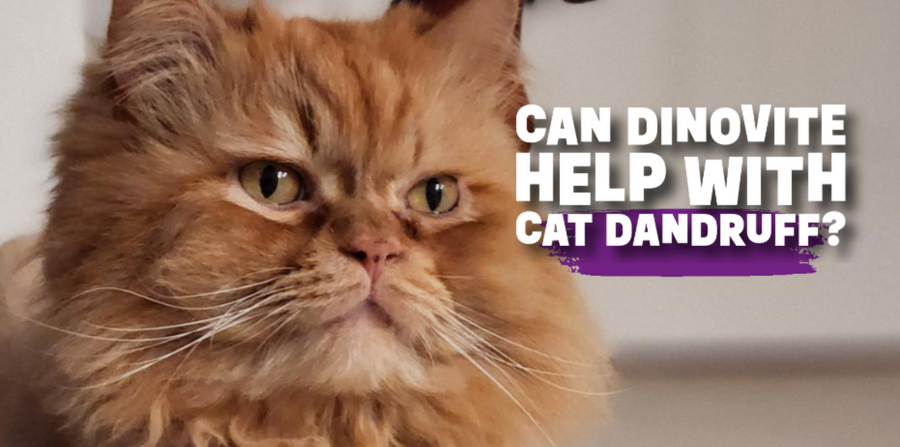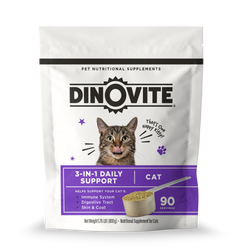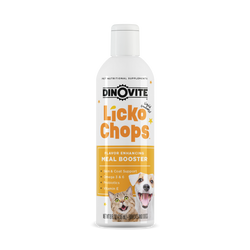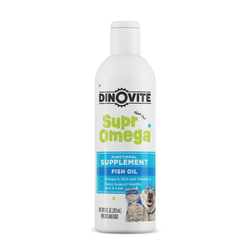How Dinovite May Be Able to Help Cat Dandruff

Cat dandruff is a common skin condition that can affect cats of all breeds, from sleek shorthairs to long-haired beauties like Persians. White or gray flakes, often visible along the back or near the tail, can be alarming to pet parents, especially when the flakes worsen after brushing.
While mild dandruff isn’t always a cause for concern, persistent dry flaky skin may signal an underlying health condition that needs attention. Let’s explore some of the common causes of cat dandruff and how to get rid of it, once and for all!

Why Does My Cat Have Dandruff on Her Back?
Cat Dandruff Causes
Dandruff often shows up along the spine or near the tail because these areas are harder for a cat to reach and groom. This is especially true for obese cats, senior cats, and exotic or long-haired breeds with thick or folded coats. Common causes of cat dandruff on the back include:
- External parasites like mites or fleas
- Lack of essential fatty acids in the diet
- Dry indoor air leading to dehydrated skin
- Poor grooming habits due to obesity or age
- Hormonal conditions such as hypothyroidism
- Allergic reactions to food, pollen, or environmental irritants
Why Does My Cat Have White Flecks in Her Fur?
White flecks in a cat's fur are typically dead skin cells — also known as dandruff. While a few flakes may be normal, large amounts or frequent recurrence could signal dry skin, nutritional deficiencies, or underlying health issues.
In cats with darker coats, especially black cats, dandruff is more visible and may seem more severe. If the flakes persist even after brushing, it's worth evaluating the cat’s diet and hydration levels.

Why Does My Cat Have Dandruff After I Brush Him?
Brushing often helps dislodge dead skin cells, making dandruff more visible temporarily. However, if brushing causes excessive flaking, it may be a sign of dry, irritated skin or an overactive sebaceous gland. Using a soft-bristle brush and following up with a leave-in moisturizing spray may help. For lasting results, nutritional support is key.
Is the Dandruff on My Cat's Back Something to Be Concerned Of?
Is cat dandruff normal? A small amount can be, especially in dry seasons. But if dandruff is accompanied by symptoms like:
- Hair loss
- Scabs or sores
- Red, inflamed skin
- Itching or excessive grooming
…it’s time to call the vet. These may indicate skin infections, parasites, or chronic health issues.

I've Noticed My Black Kitty Has Dandruff. Is This a Vet Issue?
Black-coated cats make dandruff highly visible, but visibility alone doesn’t equal severity. If the cat is behaving normally, eating well, and not scratching excessively, the flakes may simply stem from dry air or mild dehydration. A vet check is still wise if flakes persist after dietary or grooming changes.
.jpg)
Cat Dandruff in Persian Cats, Exotic Shorthairs, and Other Exotic Cat Breeds
Some breeds are more prone to dandruff due to the texture, thickness, or density of their coats. Persian cats, with their luxurious long hair and flat faces, often struggle with buildup if not groomed daily. Their dense undercoats can trap dead skin and oil close to the skin’s surface, leading to visible flakes and irritation.
Exotic Shorthairs, while technically short-haired, have a plush double coat that behaves similarly. Their grooming needs are higher than the average domestic shorthair, and they may develop dandruff if they’re not groomed regularly — especially if they’re overweight or have limited flexibility.
Tips for Managing Dandruff in Long- and Dense-Coat Cat Breeds
- Use a wide-tooth comb followed by a soft-bristle brush
- Limit bathing to avoid stripping the skin's natural moisture
- Daily brushing is essential to lift flakes and distribute skin oils
- Apply leave-in sprays formulated for cats with dry or sensitive skin
- Feed a nutrient-rich diet or supplement with omega fatty acids like those in Dinovite
Proper coat care, paired with internal support, can dramatically reduce dandruff in these high-maintenance breeds — and keep their signature coats soft, shiny, and healthy.
How Do You Get Rid of Dandruff on a Cat?
Effective cat dandruff treatment depends on the underlying cause. In many cases, dandruff can be managed with a combination of improved nutrition, consistent grooming, and environmental changes. Here are some practical ways to treat and reduce cat dandruff:
- Add humidity to dry indoor environments with a humidifier
- Use vet-approved shampoos for moisturizing and flake removal
- Groom regularly to help distribute natural oils and remove flakes
- Improve diet with fatty acid-rich foods or supplements like Dinovite
- Consult a veterinarian for underlying conditions like parasites, obesity, or hormonal imbalances
How to Treat Dandruff on Cat’s Back Near Tail
This area is a common hotspot for dandruff buildup. To treat:
- Rule out parasites with a vet visit
- Use a moisturizing, hypoallergenic cat shampoo
- Gently brush daily to loosen flakes and distribute oils
- Keep the cat’s weight in check so they can groom more easily
- Introduce an omega-3 supplement to support skin from within such as SuprOmega or LickOchops!
How to Treat Cat Dandruff at Home
Home remedies for cat dandruff can be both gentle and effective:
- Add hydration: Use a humidifier during dry months
- Groom regularly: Brushing helps stimulate oil production
- Limit baths: Over-bathing can strip the skin’s natural oils
- Offer a balanced diet: Ensure it contains omega-3s and vitamin E
-
Supplement wisely: Products like Dinovite can fill nutritional gaps
Final Thoughts
While cat dandruff is common, it doesn’t have to be permanent. With a targeted approach that includes proper grooming, environmental support, and nutritional products like Dinovite, most cats from Persians to Exotic Shorthairs and everything in between can return to having soft, healthy, flake-free coats.
Related Products



